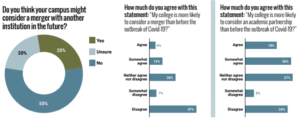The strategic partnership phone has been ringing at rpk, as institutions across the country consider the higher education landscape, look at the gaps in their FY 2024 budgets, and recognize that the proverbial can has been kicked as far down the road as it’s going to go. It’s an important moment when you’re able to say what’s wrong out loud. It makes the problem real (scary), but it also moves you toward action (freeing).
Unfortunately, too many institutions wait for that call. Only when a suitor dials do they begin considering the benefits of a strategic partnership. Strong leadership backs this process up so that their institution can get its hands on the phone.
Here are the key questions that lead to a proactive consideration of strategic partnership:
- First (always first) – What does your institution want to become? This is the shared future vision that must be created. You have to know where you’re headed if you’re going to have an honest conversation around how you’ll get there and what you’ll need.
- Do you need a partner to achieve that shared future vision?
- If you need a partner, what does an ideal partner look like? What should their program offerings reflect? What cultural traits are essential? Does geography/proximity matter?
Having addressed those questions, institutions are now positioned to find strategic partners that best reflect the ideal and begin their deeper due diligence.
Higher Education Leaders Consider Strategic Partnership Opportunities
Despite the opportunities that strategic partnerships provide, few leaders are ready to begin that exploration. In a recent survey of campus leaders by the Chronicle of Higher Education, only 25% reported they would consider an institutional merger, with 19% reporting they were more likely to consider a merger since the pandemic.
But institutional transformation can take many forms, and far more of those campus leaders (44%) would consider academic partnerships, which could include shared services, consortia agreements, or joint academic offerings. This suggests that campus leaders would be wise to consider the full spectrum of strategic partnerships – from shared administrative services, to joint program/faculty offerings, and all the way to full mergers.

Source: Chronicle of Higher Education and Workday. 2021. Stronger Together than Alone? Assessing Colleges Leaders’ Attitudes Towards Mergers and Other Partnerships.
Where Can You Go From Here?
Ready to explore strategic partnership opportunities? More information can be found on rpk’s resource page, including the deep dive needed to get to data-informed decisions.

